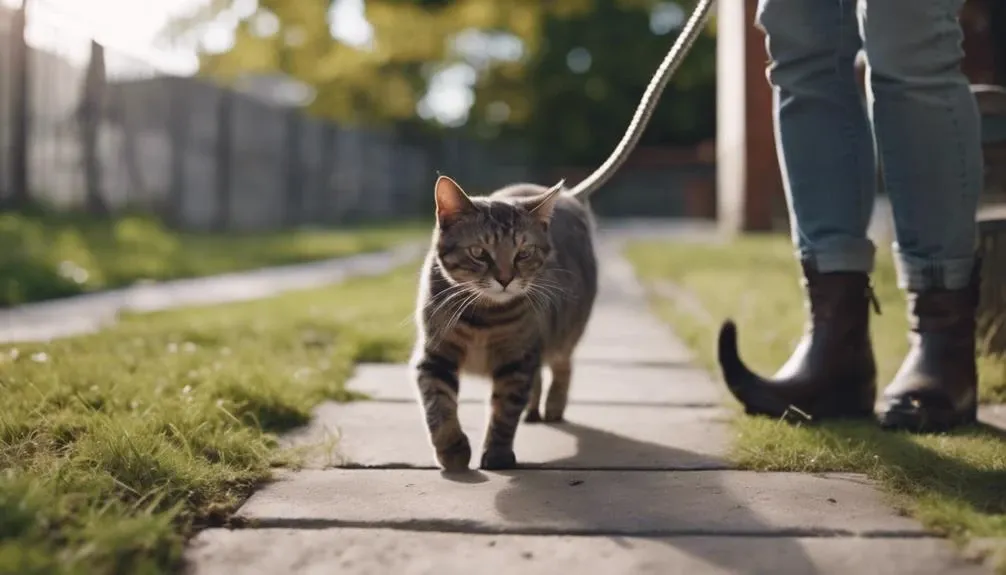The Best Fluffy Pancakes recipe you will fall in love with. Full of tips and tricks to help you make the best pancakes.

When it comes to training your cat to stay in the yard, think of it as laying down a path for your feline companion's safe exploration of the outdoor world.
Each step you take in this process serves as a building block towards creating a secure environment for your cat to roam freely.
But remember, the journey doesn't end with just these steps; there's a crucial aspect that ties it all together, ensuring your cat's well-being and your peace of mind.
Key Takeaways
- Establish physical boundaries with a cat fence or markers.
- Use positive reinforcement techniques for training.
- Create an enriching outdoor environment for your cat.
- Supervise outdoor time and adjust based on behavior.
Establish Clear Boundaries
To begin training your cat to stay in the yard, it's essential to set up clear boundaries using physical barriers like a cat fence or enclosure. These boundaries will help your outdoor cat understand the limits of their space and prevent them from wandering off. By establishing these visual markers, you can train your cat to recognize and respect the designated area.
Consistent reinforcement is key in teaching your cat to stay within the yard. Rewarding positive behavior, such as staying within the boundaries, will help reinforce this desired action. Remember to practice regularly and provide gentle guidance when needed. Cats respond well to routine and clear expectations, so be patient and persistent in your training efforts.
Positive Reinforcement Training
Using positive reinforcement training methods can effectively encourage your cat to stay within the yard. Reward your cat promptly with treats, toys, or verbal praise when they choose to remain in the designated area. Consistency is crucial in reinforcing the desired behavior, helping your cat understand expectations. Positive reinforcement training focuses on rewarding positive actions rather than punishing mistakes. Avoid using punishment or negative reinforcement techniques as they can cause fear or stress in your cat, impacting their behavior negatively.
This approach creates a positive association with staying in the yard and encourages your cat to repeat the behavior. Remember that patience and consistency are key when training your cat, and always ensure that the rewards you use are meaningful to your feline companion.
Provide Enriching Yard Environment
Encourage your cat to explore and play in the yard by creating hiding spots and elevated areas that cater to their natural instincts. Set up cozy shelters or small nooks where your cat can feel safe and secure while observing their surroundings. Provide platforms or perches that allow your cat to survey the yard from above, satisfying their curiosity. Incorporate cat-friendly plants like catnip or cat grass to add sensory enrichment to their outdoor experience. These plants can engage your cat's sense of smell and taste, making the yard a more enticing place to spend time.
To keep your cat entertained, offer a variety of toys and scratching posts scattered around the yard. This will encourage play and provide mental stimulation. Ensure there's always fresh water available and a designated litter area to meet your cat's basic needs and encourage them to stay within the yard. By creating an enriching yard environment with plenty of opportunities for exploration and play, you can make outdoor stays enjoyable and engaging for your cat.
Supervised Outdoor Time
Supervising your cat during outdoor time is essential for ensuring their safety and well-being while they explore the yard. It allows you to monitor their interactions with the environment, intervene in case of potential hazards, and set boundaries crucial for their training. Through supervised outings, you can train your cat to stay in the yard while building trust and reinforcing positive behaviors. Below is a table to help you understand the importance of supervised outdoor time for your feline friend:
| Benefits of Supervised Outdoor Time |
|---|
| Ensures safety and well-being |
| Monitors interactions |
| Intervenes in potential hazards |
| Establishes boundaries for training |
Consistent Monitoring and Adjustments
To ensure your cat remains safely within the yard, consistently monitoring their behavior and making necessary adjustments is crucial for their training and well-being. Here are some essential steps to keep your cat safe and prevent them from escaping:
- Regularly monitor your cat's behavior in the yard to prevent your cat from escaping.
- Make adjustments to the yard or cat enclosures based on your cat's attempts to wander.
- Use positive reinforcement techniques to encourage your cat to stay within the designated area.
- Implement deterrents in areas where your cat tries to escape, such as motion-activated devices or natural barriers.
Consistent supervision is key as you train your fur baby to stay in the yard. By being attentive and proactive, you can create a safe environment that keeps your cat secure and protected from potential dangers like wild animals.
Frequently Asked Questions
How Do I Train My Cat to Stay in the Yard?
To train your cat to stay in the yard, focus on outdoor adventures, setting feline boundaries, and yard exploration. Use cat containment methods, training techniques, and positive reinforcement. Supervised outings, escape prevention, and boundary reinforcement ensure outdoor safety.
How Do I Keep My Cat From Leaving the Yard?
To keep your cat from leaving the yard, focus on setting clear yard boundaries, using safe containment methods like cat-proof fencing, and providing supervised playtime. Incorporate positive reinforcement, deterrent options, and consider leash training for outdoor cat training.
How Do You Confine a Cat to Your Yard?
To confine a cat to your yard, consider using outdoor enclosures, electronic fences, boundary training, and supervised playtime. Use cat-friendly plants, deterrent devices, positive reinforcement, leash training, outdoor toys, and secure fencing. This helps ensure your cat's safety and enjoyment.
Can You Train a Cat to Stay Outside?
You can train a cat to stay outside by setting clear outdoor boundaries, understanding cat behavior, using positive reinforcement techniques, and catering to their feline instincts through outdoor enrichment. Supervised playtime and proper safety measures are essential.
Conclusion
In conclusion, training your cat to stay in the yard is a rewarding process that requires patience and consistency. By following the five key steps outlined, you can create a safe and stimulating outdoor environment for your feline friend.
Remember to establish clear boundaries, use positive reinforcement, provide enrichment, supervise outdoor time, and consistently monitor and adjust as needed.
With dedication and effort, you can successfully train your cat to enjoy the outdoors while staying safe and secure.










